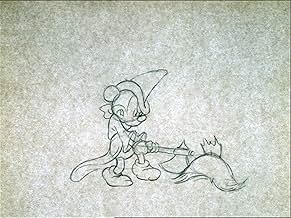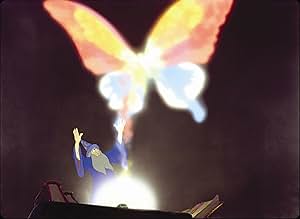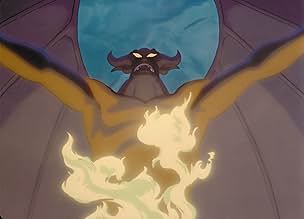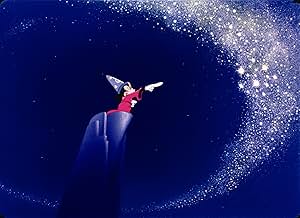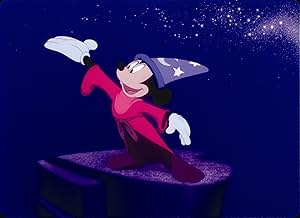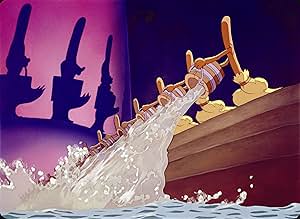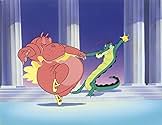Une suite de huit dessins animés illustrant de grands morceaux de musique classique.Une suite de huit dessins animés illustrant de grands morceaux de musique classique.Une suite de huit dessins animés illustrant de grands morceaux de musique classique.
- Prix
- 9 victoires et 1 nomination au total
Corey Burton
- Narrator: Deems Taylor overdubs (2000 restoration)
- (voice)
- (uncredited)
Walt Disney
- Mickey Mouse (segment 'The Sorcerer's Apprentice')
- (voice)
- (uncredited)
Hugh Douglas
- Narrator (1982 version)
- (voice)
- (uncredited)
James MacDonald
- Percussionist
- (uncredited)
Tim Matheson
- Narrator (1985 version)
- (voice)
- (uncredited)
Julietta Novis
- Soloist (segment 'Ave Maria')
- (singing voice)
- (uncredited)
Paul J. Smith
- Violinist
- (uncredited)
Avis en vedette
Fantasia was to be the crowning achievement of Walt Disney Studios, their magnum opus, a work of art that finally convinced the people that animated films could be more than "mere" children's entertainment. Unfortunately, it was too much too soon. People went in expecting children's entertainment - after all, that's what Disney was known for - and instead were treated to high art. Nothing wrong with that, but you need to expect it first. And thus, Fantasia flopped financially, and what was meant to be a continuing series of films, remained just one until the turn of the century.
But oh what a film it is. Music by the best classical composers ever lived, performed by the Philadelphia Orchestra, hosted by Deems Taylor, featuring some the finest animated segments Disney had ever done. It's a stone cold classic, was from the very first moment, and it's a shame it didn't do so well. Luckily it has gone down in history as one of Disney's finest and will be watched and appreciated for centuries to come.
As for the individual segments, they're not of equal quality, though they are all very good in their own ways.
The opening segment, Toccata and Fugue in D Minor, is not one of my personal favourites, but it works as a good opening intro to the idea behind Fantasia and is pretty to look at in its own way. It hasn't aged as well as some of the other segments, but it does its job more than adequately.
Nutcracker Suite, on the other hand, is fantastic. Beautiful images, perfectly accompanied by one of the most recognizable pieces of music there is. After seeing this segment once, it's hard not to see fairies and seasons dancing around whenever you hear the piece.
And then there's The Sorcerer's Apprentice. Everyone knows this one and has most probably seen it, even if they haven't seen the whole film. It's the segment with the most story and is one of the strongest Mickey Mouse shorts ever made. Grandeur, funny and even a bit threatening, it's probably the film's strongest moment.
Rite of Spring is another one with a story, this time about the history of our small blue orb floating in the space. It's intriguing to watch, but once again the animation shows a bit of its age and it's perhaps even a little bit too ambitious for its running length. Not the strongest segment, but once again very good nonetheless.
The Pastoral Symphony and Dance of the Hours, the next two segment, are to me very similar and while they're both fine, I cannot admit to liking them all that much. They're mostly just general gallivanting and while that's fine and fits the music, it can become a bit boring. The Pastoral Symphony is also the segments that has aged the least gracefully with some really rough character designs.
Luckily we have Night on Bald Mountain and Awe Maria to close the film. And they are awe-inspiring. The devil on his lone mountain top is one of the scariest images Disney has ever produced and the rest of the segment is equally haunting, eerie and threatening. Which is why the following tranquility and quietness of Awe Maria works so well and allows you to drift over the finish line with a smile on your face and peace in your heart.
Fantasia is not a perfect film, but it's still one of the finest pieces of art I've ever seen and a perfect introduction to animated films meant for adults. As a child I found it slightly boring. As an adult I'm in awe.
But oh what a film it is. Music by the best classical composers ever lived, performed by the Philadelphia Orchestra, hosted by Deems Taylor, featuring some the finest animated segments Disney had ever done. It's a stone cold classic, was from the very first moment, and it's a shame it didn't do so well. Luckily it has gone down in history as one of Disney's finest and will be watched and appreciated for centuries to come.
As for the individual segments, they're not of equal quality, though they are all very good in their own ways.
The opening segment, Toccata and Fugue in D Minor, is not one of my personal favourites, but it works as a good opening intro to the idea behind Fantasia and is pretty to look at in its own way. It hasn't aged as well as some of the other segments, but it does its job more than adequately.
Nutcracker Suite, on the other hand, is fantastic. Beautiful images, perfectly accompanied by one of the most recognizable pieces of music there is. After seeing this segment once, it's hard not to see fairies and seasons dancing around whenever you hear the piece.
And then there's The Sorcerer's Apprentice. Everyone knows this one and has most probably seen it, even if they haven't seen the whole film. It's the segment with the most story and is one of the strongest Mickey Mouse shorts ever made. Grandeur, funny and even a bit threatening, it's probably the film's strongest moment.
Rite of Spring is another one with a story, this time about the history of our small blue orb floating in the space. It's intriguing to watch, but once again the animation shows a bit of its age and it's perhaps even a little bit too ambitious for its running length. Not the strongest segment, but once again very good nonetheless.
The Pastoral Symphony and Dance of the Hours, the next two segment, are to me very similar and while they're both fine, I cannot admit to liking them all that much. They're mostly just general gallivanting and while that's fine and fits the music, it can become a bit boring. The Pastoral Symphony is also the segments that has aged the least gracefully with some really rough character designs.
Luckily we have Night on Bald Mountain and Awe Maria to close the film. And they are awe-inspiring. The devil on his lone mountain top is one of the scariest images Disney has ever produced and the rest of the segment is equally haunting, eerie and threatening. Which is why the following tranquility and quietness of Awe Maria works so well and allows you to drift over the finish line with a smile on your face and peace in your heart.
Fantasia is not a perfect film, but it's still one of the finest pieces of art I've ever seen and a perfect introduction to animated films meant for adults. As a child I found it slightly boring. As an adult I'm in awe.
Disney's "Fantasia" is a pure classic.
What we are shown are a few animated musicals, filled with grand splendor and vivid colors.
"Fantasia" is one of those films that everyone knows by heart, and has watched since being a child.
My personal favorite was always the Mickey Mouse short - one of the darkest Mickey cartoons I've ever seen.
If you haven't seen "Fantasia" yet, then you must be from another planet. It is one of the best Disney musicals ever, which some push aside and forget too easily.
5/5 stars-
John Ulmer
What we are shown are a few animated musicals, filled with grand splendor and vivid colors.
"Fantasia" is one of those films that everyone knows by heart, and has watched since being a child.
My personal favorite was always the Mickey Mouse short - one of the darkest Mickey cartoons I've ever seen.
If you haven't seen "Fantasia" yet, then you must be from another planet. It is one of the best Disney musicals ever, which some push aside and forget too easily.
5/5 stars-
John Ulmer
This unusual and very creative classic of animation combines a very interesting idea with quite a bit of imagination, plus visual effects that still hold up quite well. All but a couple of the sequences are quite enjoyable, and some especially so. Even the segments that don't work as well are usually at least interesting, since you can at least appreciate what they were trying to accomplish.
You don't really have to be all that familiar with the specific pieces of music for it to be worthwhile, since in several cases they chose to match the music with material that is rather different in nature from any original context that it may have had. And in any case, the animated sequences are intended to provide the context, in terms of the movie.
No doubt, everyone will have his or her own favorite segments, based on the music itself and on the choice of accompanying visual material. The "Sorcerer's Apprentice" sequence, with Mickey Mouse, is certainly one of the most memorable. The adaptation of "The Rite of Spring" is quite imaginative in using an entirely different setting for the music. "Night on Bald Mountain" has striking and sometimes bizarre visuals.
Many of the classic Disney features still hold up well as family entertainment, but "Fantasia" is unique for its combination of imaginative concept and visual creativity. Not every minute of it works, but that's the price of being willing to experiment. It's an enjoyable and satisfying feature that well deserves to be remembered.
You don't really have to be all that familiar with the specific pieces of music for it to be worthwhile, since in several cases they chose to match the music with material that is rather different in nature from any original context that it may have had. And in any case, the animated sequences are intended to provide the context, in terms of the movie.
No doubt, everyone will have his or her own favorite segments, based on the music itself and on the choice of accompanying visual material. The "Sorcerer's Apprentice" sequence, with Mickey Mouse, is certainly one of the most memorable. The adaptation of "The Rite of Spring" is quite imaginative in using an entirely different setting for the music. "Night on Bald Mountain" has striking and sometimes bizarre visuals.
Many of the classic Disney features still hold up well as family entertainment, but "Fantasia" is unique for its combination of imaginative concept and visual creativity. Not every minute of it works, but that's the price of being willing to experiment. It's an enjoyable and satisfying feature that well deserves to be remembered.
2017 is a year of technical marvel. Looking at movies of today, we see massive, stunning works of animation. We can now achieve computer generated images that look nearly indistinguishable from reality, and at the forefront of movie making today is Disney. Through Marvel, Disney creates multiple action packed superhero blockbusters a year. Star Wars, after it's 2015 revival, has new movies being released annually. Pixar, after creating several successful franchises, is now resting on its laurels, creating sequels like Finding Dory, Toy Story 4, Cars 3 and Incredibles 2. Even Disney's in house animation team is finding success, bringing back the Disney princess formula with movies like Frozen and Moana. However, amidst all this success, we have lost the truly human touch. Fantasia perfectly captures all that was lost in today's Disney movies. The movie has a very personal and human feel to every aspect of it. The orchestra, a very tangible presence in the movie, feels alive. They laugh, play their own little tunes during the intermission, but most importantly, they make mistakes. The animation is the same way, It's very rough at times and sometimes lacking, with some animations being reused, however every shot is filled with passion. You can tell that people worked on this, people with ambition, though they were not perfect. In modern movies, this beautiful animation that looks so real lacks the touch of individualism that Fantasia has in spades. The scene of the Sorcerer's apprentice dancing around the broom is burned into our collective memory for a reason. In all its flaws, its rough edges, it feels real to us. We can see all the raw effort and energy that the animator's put into each of Mickey's footsteps and that resonates with us. Fantasia speaks to the viewer not because it's perfect, but because it's flawed.
This without a doubt the greatest animated film in history. While highly acclaimed and well-known today, it was not terribly popular when it was first released. The idea of "Fantasia" is to take great pieces of music and draw animated sequences that match them. In doing so, it reverses the purpose of a movie's score; the movie serves and matches the music, not the other way around. This set up also means that there is no typical formula plot that is present in the vast majority of movies. In the first piece, the animation is vague and abstract, but in later ones it is of definite actions, objects, and stories. The two most famous(and my favorite) parts are probably "The Sorcerer's Apprentice" and "Rite of Spring". "Fantasia" is not only the best animated film ever made, but one of the greatest films period.
Le saviez-vous
- AnecdotesDuring production, the animators were given no instructions for coloring. Walt Disney instructed them to use any colors they wanted, which was a first.
- GaffesWhen introducing the "Pastoral" sequence, Deems Taylor mixes Greek and Roman names of deities: Bacchus, Vulcan and Diana are Roman; Zeus, Iris and Morpheus are Greek. Apollo is the only one whose Greek and Roman equivalents have the same name.
- Citations
Mickey Mouse: [Pulling on Stokowski's coat] Mr. Stokowski! Mr. Stokowski!
[Mickey whistles to get Stokowski's attention]
Mickey Mouse: My congratulations, sir!
Leopold Stokowski: [shaking hands with Mickey] Congratulations to you, Mickey!
Mickey Mouse: Gee, thanks! Hehe! Well, so long! I'll be seeing ya!
Leopold Stokowski: Goodbye!
- Générique farfeluThere are no closing credits of any kind. Not even the words "THE END" appear on the screen.
- Autres versionsBefore the 1990 re-release, the film was shown with no credits other than the title and the RKO logo. Leopold Stokowski received a written credit only on the posters advertising the film. In the film's original roadshow release, not even the title was shown at the beginning of the film - that was saved for the intermission break.
- ConnexionsEdited into A World Is Born (1955)
- Bandes originalesToccata and Fugue in D Minor, BWV 565
Composed by Johann Sebastian Bach
Orchestrated by Leopold Stokowski (uncredited)
Played by The Philadelphia Orchestra
Conducted by Leopold Stokowski
Meilleurs choix
Connectez-vous pour évaluer et surveiller les recommandations personnalisées
- How long is Fantasia?Propulsé par Alexa
- How many different versions of Fantasia are there?
- How come many of the pieces do not follow a story?
Détails
Box-office
- Budget
- 2 280 000 $ US (estimation)
- Brut – États-Unis et Canada
- 76 408 097 $ US
- Fin de semaine d'ouverture – États-Unis et Canada
- 980 798 $ US
- 10 févr. 1985
- Brut – à l'échelle mondiale
- 76 414 517 $ US
- Durée2 heures 4 minutes
- Couleur
- Mixage
- Rapport de forme
- 1.37 : 1
Contribuer à cette page
Suggérer une modification ou ajouter du contenu manquant






